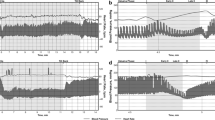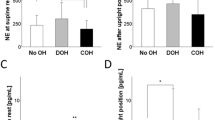Abstract
Postprandial hypotension is one of the most important autonomic disorders in Parkinson’s disease. However, its predictors remain unclear. We investigated which variable(s) predict the presence of postprandial hypotension in elderly patients with Parkinson’s disease. The subjects were 64 patients with de novo Parkinson’s disease who were 70 years or older. Postprandial hypotension was evaluated on a 75-g oral glucose tolerance test. Olfactory function, constipation, cardiac sympathetic or parasympathetic denervation, orthostatic intolerance on head-up tilt table testing, and other baseline characteristics were evaluated. The results showed the presence of postprandial hypotension was associated with severe dysosmia, constipation, orthostatic hypotension (a decrease in systolic blood pressure ≥30 mmHg) and preprandial hypertension at rest. On multiple logistic regression analyses adjusted for age, sex, symptom duration, disease severity, and motor subtype, the odds ratio was 4.02 for severe dysosmia (p = 0.027), 9.99 for constipation (p = 0.006), 6.42 for orthostatic hypotension with alternative definition (p = 0.004) and 7.90 for preprandial hypertension at rest (p = 0.001). Each multiple logistic regression analysis revealed that female sex was also a risk factor for postprandial hypotension. The variables with the highest sensitivity and specificity for postprandial hypotension were constipation (89.6 %) and preprandial hypertension at rest or orthostatic hypotension with alternative definition (both 77.1 %), respectively. Our results suggest that these variables predict the presence of postprandial hypotension in elderly patients with Parkinson’s disease, suggesting that postprandial hypotension shares etiologic factors with these potential predictors.

Similar content being viewed by others
References
Allcock LM, Kenny RA, Burn DJ (2006) Clinical phenotype of subjects with Parkinson’s disease and orthostatic hypotension: autonomic symptom and demographic comparison. Mov Disord 21:1851–1855
Baba T, Takeda A, Kikuchi A et al (2011) Association of olfactory dysfunction and brain. Metabolism in Parkinson’s disease. Mov Disord. 26:621–628
Braak H, Del Tredici K, Ru U, de Vos RA, Jansen Steur EN, Braak E (2003) Staging of brain pathology related to sporadic Parkinson’s disease. Neurobiol Aging 24:197–211
Freeman R, Wieling W, Axelrod FB et al (2011) Consensus statement on the definition of orthostatic hypotension, neutrally mediated syncope and the postural tachycardia syndrome. Clin Auton Res 21:69–72
Goldstein DS, Holmes CS, Dendi R, Bruce SR, Li ST (2002) Orthostatic hypotension from sympathetic denervation in Parkinson’s disease. Neurology 58:1247–1255
Hakusui S, Sugiyama Y, Iwase S et al (1991) Postprandial hypotension: microneurographic analysis and treatment with vasopressin. Neurology 41:712–715
Hara T, Hirayama M, Mizutani Y et al (2013) Impaired pain processing in Parkinson’s disease and its relative association with the sense of smell. Parkinsonism Relat Disord 19:43–46
Hashimoto Y, Fukuzawa K, Fujii M et al (2004) Usefulness of the odor stick identification test for Japanese patients with olfactory dysfunction. Chem Senses 29:565–571
Hirayama M, Watanabe H, Koike Y et al (1993) Postprandial hypotension: hemodynamic differences between multiple system atrophy and peripheral autonomic neuropathy. J Auton Nerv Syst 43:1–6
Hughes AJ, Daniel SE, Kilford L, Lees AJ (1992) Accuracy of clinical diagnosis of idiopathic Parkinson’s disease. A clinico-pathological study of 100 cases. J Neurol Neurosurg Psychiatry 55:181–184
Iijima M, Kobayakawa T, Saito S et al (2008) Smell identification in Japanese Parkinson’s disease patients: using the odor stick identification test for Japanese subjects. Intern Med 47:1887–1892
Izawa MO, Miwa H, Kajimoto Y, Kondo T (2012) Combination of transcranial sonography, olfactory testing, and MIBG myocardial scintigraphy as a diagnostic indicator for Parkinson’s disease. Eur J Neurol 19:411–416
Jansen RW, Lipsitz LA (1995) Postprandial hypotension: epidemiology, pathophysiology, and clinical management. Ann Intern Med 122:286–295
Jones BE, Yang TZ (1985) The efferent projections from the reticular formation and the locus coeruleus studied by anterograde and retrograde axonal transport in the rat. J Comput Neurol 242:56–92
Kawamura H, Gunn CG, Frohlich ED (1978) Cardiovascular alteration by nucleus locus coeruleus in spontaneously hypertensive rat. Brain Res 140:137–147
Le Couteur DG, Fisher AA, Davis MW, McLean AJ (2003) Postprandial systolic blood pressure responses of older people in residential care: association with risk of falling. Gerontology 49:260–264
Lipsitz LA, Pluchino FC, Wei JY, Minaker KL, Rowe JW (1986) Cardiovascular and norepinephrine responses after meal consumption in elderly (older than 75 years) persons with postprandial hypotension and syncope. Am J Cardiol 58:810–815
Loew F, Gauthey L, Koerffy A et al (1995) Postprandial hypotension and orthostatic blood pressure responses in elderly Parkinson’s disease patients. J Hypertens 13:1291–1297
Longstreth GF, Thompson WG, Chey WD, Houghton LA, Mearin F, Spiller RC (2006) Functional bowel disorders. Gastroenterology 130:1480–1491
Mathias CJ (1991) Postprandial hypotension. Pathophysiological mechanisms and clinical implications in different disorders. Hypertension 18:694–704
Miyamoto T, Miyamato M, Iwanami M, Suzuki K, Inoue Y, Hirata K (2009) Odor identification test as an indicator of idiopathic REM sleep behavior disorder. Mov Disord 24:268–273
Mugie SM, Benninga MA, Di Lorenzo C (2011) Epidemiology of constipation in children and adults: a systemic review. Best Pract Res Clin Gastroenterol 25:3–18
Nagamachi S, Wakamatsu H, Kiyohara S et al (2008) Usefulness of rCBF analysis in diagnosing Parkinson’s disease: supplemental role with MIBG myocardial scintigraphy. Ann Nucl Med 22:557–564
Ogihara H, Kobayashi M, Nishida K, Kitano M, Takeuchi K (2011) Applicability of the cross-culturally modified University of Pennsylvania smell identification test in a Japanese population. Am J Rhinol Allergy 25:404–410
Oka H, Toyoda C, Yogo M, Mochio S (2010) Olfactory dysfunction and cardiovascular dysautonomia in Parkinson’s disease. J Neurol 257:969–976
Pfeiffer RF (2003) Gastrointestinal dysfunction in Parkinson’s disease. Lancet Neurol 2:107–116
Puisieux F, Bulckaen H, Fauchais AL, Drumez S, Salomez-Granier F, Dewailly P (2000) Ambulatory blood pressure monitoring and postprandial hypotension in elderly persons with falls or syncopes. J Gerontol A Biol Sci Med Sci 55:M535–M540
Puvi-Rajasingham S, Mathias CJ (1996) Effect of meal size on post-prandial blood pressure and on postural hypotension in primary autonomic failure. Clin Auton Res 6:111–114
Senard JM, Raï S, Lapeyre-Mestre M et al (1997) Prevalence of orthostatic hypotension in Parkinson’s disease. J Neurol Neurosurg Psychiatry 63:584–589
Seyer-Hansen K (1977) Postprandial hypotension. Br Med J 2:1262
Shibata M, Morita Y, Shimizu T, Takahashi K, Suzuki N (2009) Cardiac parasympathetic dysfunction concurrent with cardiac sympathetic denervation in Parkinson’s disease. J Neurol Sci 276:79–83
Sidery MB, Macdonald IA, Blackshaw PE (1994) Superior mesenteric artery blood flow and gastric emptying in humans and the differential effects of high fat and high carbohydrate meals. Gut 35:186–190
Spiegel J, Hellwig D, Samnick S et al (2007) Striatal FP-CIT uptake differs in the subtypes of early Parkinson’s disease. J Neural Transm 114:331–335
Suares NC, Ford AC (2011) Prevalence of, and risk factors for, chronic idiopathic constipation in the community: systematic review and meta-analysis. Am J Gastroenterol 106:1582–1591
Suzuki M, Hashimoto M, Yoshioka M, Murakami M, Kawasaki K, Urashima M (2011) The odor stick identification test for Japanese differentiates Parkinson’s disease from multiple system atrophy and progressive supra nuclear palsy. BMC Neurol 11:157
Szewczyk-Krolikowski K, Tomlinson P, Nithi K et al (2014) The influence of age and gender on motor and non-motor features of early Parkinson’s disease: initial findings from the Oxford Parkinson Disease Center (OPDC) discovery cohort. Parkinsonism Relat Disord 20:99–105
Task Force of the European Society of Cardiology, the North American Society of Pacing and Electrophysiology (1996) Heart rate variability: standards of measurement, physiological interpretation, and clinical use. Eur Heart J 17:354–381
Teramoto S, Akishita M, Fukuchi Y, Toba K, Ouchi Y (1997) Assessment of autonomic nervous function in elderly subjects with or without postprandial hypotension. Hypertens Res 20:257–261
Uetani E, Tabara Y, Igase M et al (2012) Postprandial hypertension, an overlooked risk marker for arteriosclerosis. Atherosclerosis 224:500–505
Umehara T, Toyoda C, Oka H (2014) Postprandial hypotension in de novo Parkinson’s disease: a comparison with orthostatic hypotension. Parkinsonism Relat Disord 20:573–577
Vloet LC, Pel-Little RE, Jansen PA, Jansen RW (2005) High prevalence of postprandial and orthostatic hypotension among geriatric patients admitted to Dutch hospitals. J Gerontol A Biol Sci Med Sci 60:1271–1277
Author information
Authors and Affiliations
Corresponding authors
Ethics declarations
Disclosures
Dr. Tadashi Umehara reports no disclosures. Dr. Atsuo Nakahara reports no disclosures. Dr. Hiromasa Matsuno reports no disclosures. Dr. Chizuko Toyoda reports no disclosures. Dr. Hisayoshi Oka reports no disclosures. There is no conflict of interest. There was no sponsorship or funding for this report.
Rights and permissions
About this article
Cite this article
Umehara, T., Nakahara, A., Matsuno, H. et al. Predictors of postprandial hypotension in elderly patients with de novo Parkinson’s disease. J Neural Transm 123, 1331–1339 (2016). https://doi.org/10.1007/s00702-016-1594-6
Received:
Accepted:
Published:
Issue Date:
DOI: https://doi.org/10.1007/s00702-016-1594-6




